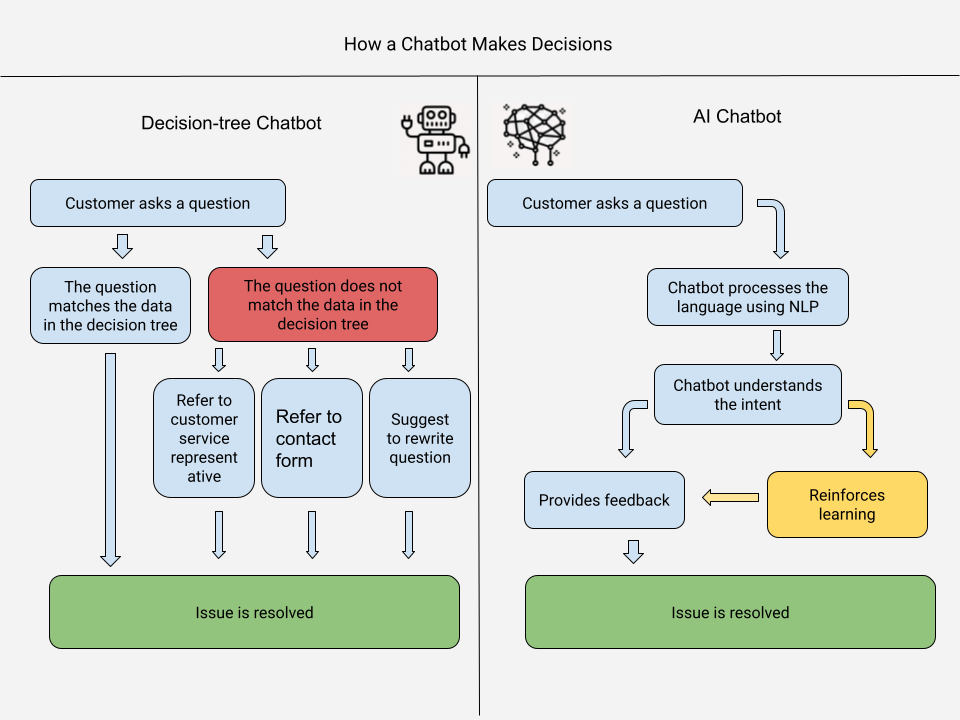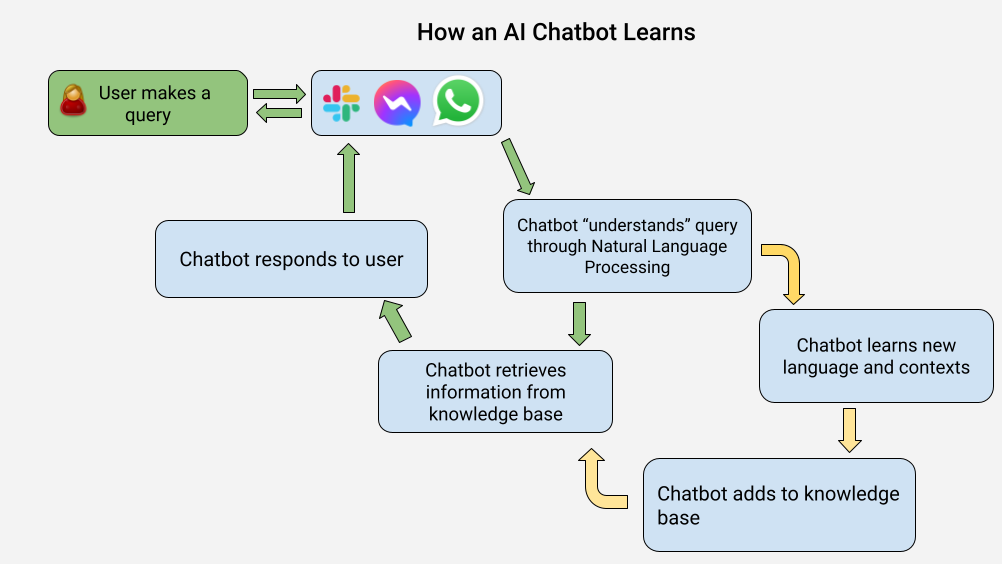Build a Chatbot: What You Need to Know
Previously, you'd only see chatbots on airline website: that message bubble that gets in between you and a human customer service representative.
Chatbots have gone a long way. Today, big names like Adobe and GoPro all rely on chatbots to handle massive traffic of queries.
Chatbots have increased customer response time and reduced the stress on human customer service representatives. For customers whose issues are resolved without the need of human assistance, it is a pleasant surprise.
For those who still need to talk to an actual person, chatbots have helped connect them to the person with the right expertise and tool set. chatbots are a win for both ends. The question now: is a chatbot right for you? Or is it just for big brands and airline companies?
What is a chatbot?
Chatbot is a broad term that encompasses Alexa, Google Assistant, and that pop-up dialogue box on websites.
As the technology for building chatbots become more accessible, many small-to-medium enterprises (SMEs) are using chatbots to help customers find the information they need or complete a transaction. In these cases, chatbots function as virtual agents: interactive bots that can fulfill complex requests.
Components
- Natural Language Processing (NLP) engine. An NLP engine is a piece of software that interprets what users type or say. Google's Dialogflow, Amazon comprehend, and Microsoft Luis are some examples.
- Knowledge base. A knowledge base is the information center of chatbots -- it is where they get their answers to questions. If you have an online shop, an FAQ can be converted into your first knowledge base.
Garbage in, garbage out is a common phrase in building chatbots. That means to say that the information a chatbot can provide is only as good as its knowledge base.
- Security. There is a long list of threats and vulnerabilities that come with integrating a chatbot. Security is an imperative in order to authenticate users, protect consumer and business data, and ward off attacks.
Two types of chatbots
A simplified diagram of how chatbots make decisions.
Rule-based
A rule-based chatbot, also called a decision-tree bot, follows a diagram of mapped out conversations to resolve problems.
Rule-based chatbots can be frustrating to deal with. That is why AI-powered chatbots are being more common.
Advantage:
Cheaper and faster to build.
Disadvantage:
Cannot answer questions that are outside the decision tree.
Artificial intellligence (AI)
An AI bot uses natural language processing (NLP) to understand the various ways that a person might ask the same question. It is able to try to understand a user's intent, instead of merely parsing a query word-by-word.
Advantages:
Can identify user intent, not restricted by what is contained in a decision tree.
A well-trained chatbot delivers a better end-user experience compared to a decision-tree bot.
Disadvantage:
- Can take longer to train. Training is necessary for an AI chatbot to better understand human language and interpret customer intent.
An AI chatbot is trained by getting feedback from users and using feedback to reinforce learning.
Does your company need a chatbot?
A chatbot provides 24/7 support and reduces routine work that reach employees.
These questions can help you decide if a chatbot can be a worthwhile investment for you.
What value can a chatbot add to your business?
Before investing on a chatbot, you should have a clear view of what value it can offer. These are some ways that a chatbot can help:
- Increase sales by suggesting products that are related to what a customer is buying.
- Reduce cart abandonment by offering help at the product checkout.
- Reduce the workload of managers and knowledge experts by answering common employee questions.
You may also ask these questions:
Are there customer interactions that seem redundant and can be automated?
Chatbots can offload routine customer interactions from your customer service representatives. This saves them time to focus on more complex problems.
How can a chatbot make my customers or clients happier?
Chatbots can provide 24/7 support, which is reassuring for customers. Chatbots are also an engaging alternative to FAQs.
How can a chatbot make my employees better and happier at their job?
Chatbots can retrieve customer information before live human agents interact with customers. This helps employees skip tedious work.
Do you have the time and resources to train a chatbot?
This question is relevant if you plan to build a virtual agent, since virtual agents need to perform more complex tasks. Consequently, they need to respond to customers who may use a wide variety of vocabulary and sentence structures.
How likely are your customers likely to use a chatbot?
Millennial and younger end-users are more likely to engage with an automated service. It is important to factor in the age group of your target when deciding to build a chatbot.
Do you have a team of knowledge experts who can respond to requests or queries that a chatbot cannot resolve?
An end-user may want to skip over working with a chatbot. There might be questions that a chatbot cannot answer. Having humans that can serve as safety nets are an important part of your chatbot strategy.
Platforms for chatbots
If you have decided that you want to build a chatbot, the next natural question is: Where do you put it?
There are a number of platforms where you can integrate a chatbot or virtual agent into.
WhatsApp Business
Whatsapp is a messaging freeware that offers a standalone mobile app called WhatsApp Business. WhatsApp Business can also be integrated into your website.
WhatsApp itself does not provide chatbot services. However, it is possible to integrate a third-party tool such as Google's Dialogflow into WhatsApp.
Here are the things that you can do when you integrate a chatbot with WhatsApp:
- Provide business information such as hours and location.
- Showcase a catalog so that customers can browse through your products and services.
- Create automated responses for frequently asked questions.
- Provide information about your email and social media accounts.
- Help customers complete a transaction such as buying a product or booking a service.
Facebook Messenger
Messenger marketing has been around for years. Many companies have leveraged the power of Facebook's Messenger app to directly interact with current and potential customers. The brands that stand out use chatbots to do things faster and better.
Here's how businesses big and small are using chatbots on Messenger:
- Answer typical questions like store hours and location.
- Request phone numbers or email addresses from customers
- Lead customer to the right channel (explore products, customer service, add screenshot)
What do you need to get started?
- A business page on Facebook.
- A chatbot that you will integrate into Facebook Messenger. There are many paid, out-of-the-box services that you can find online by searching for
facebook chatbot builder.
Internal collaboration platforms
You can create custom chatbots that can help employees do things faster and make their jobs easier. You can integrate chatbots on collaboration platforms like Slack and Microsoft Teams.
These are some ways that companies use a chatbot to help employees perform better and reduce the workload on management personnel:
Onboarding tool. A chatbot can be designed to respond to questions that are frequently asked by new employees.
Knowledge base. Instead of having to check a typical company handbook, employees can throw their questions directly to the bot.
Automate tasks. A chatbot can be used to set repeated reminders. It can also be designed to collect ideas or employee sentiments, and store the responses in a spreadsheet.
HR resource. A chatbot can be designed to answer frequently asked human resource questions such as questions about pay stubs or policies for going back to the office.
Anything that involves performing repetitive tasks or requiring access to a knowledge base can be automated with a chatbot. This list can go on.
Different ways to build a chatbot
You can build simple, rule-based chatbots without the need to code. Virtual agents require some coding skills on your part or the help of a custom software development company.
Create your own
Zero-code chatbot builders. A simple search with the keywords no code chatbot builder will lead you to services that promise you can build a chatbot in 15 minutes.
The catch? These 15-minute builds are typically limited in their ability to engage in a conversation. Plus, it does not factor in the time it takes to integrate the bot into your website or social media page.
Open-source chatbots. There are several open-source chatbots that you (or your in-house IT team) can use to create your own custom chatbot.
Facebook's Blender Bot, Microsoft's Bot Framework, and RASA are examples of open-source chatbot frameworks.
Custom software development with a third-party provider
Do you need a software development company to build a chatbot? The answer is yes and no.
You can build a simple chatbot that can answer simple questions like store location and payment methods. However, it takes a programming skillset to build a non-trivial chatbot that can deliver a quality user experience.
This means you need to invest in custom software development. In return, you will get:
- A reduced human resource overhead because bots can respond to common questions or automate repetitive tasks.
- A more rewarding customer experience because chatbots can respond quickly 24/7. If it is not able to resolve an issue, a chatbot can escalate the issue to a knowledge expert.
Do you have questions about building your own chatbot? Schedule a call with our CTO.


